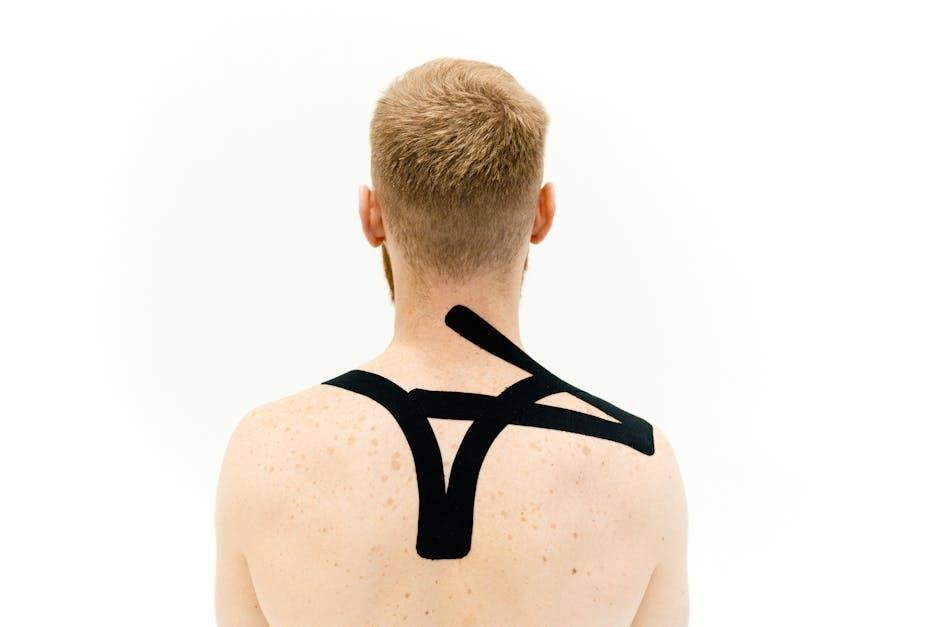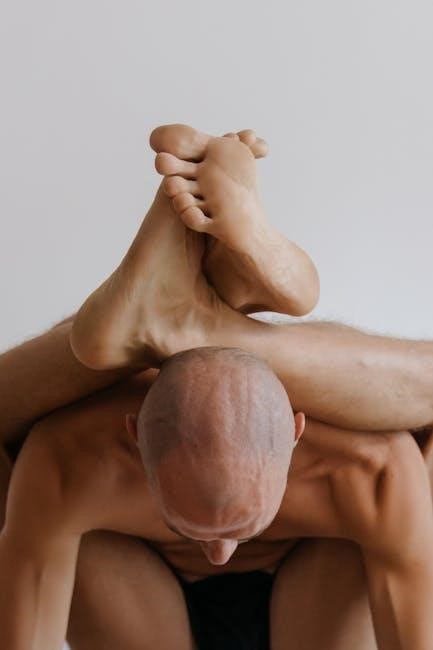Upper back stretches are simple yet effective exercises that target tension in the thoracic spine and surrounding muscles․ Regular stretching can improve posture, reduce muscle strain, and enhance overall mobility․ These exercises are easy to incorporate into your daily routine, even with a busy schedule․

Key Muscle Groups in the Upper Back
The upper back region comprises several key muscle groups that play a crucial role in posture, movement, and overall stability․ The primary muscles include the trapezius, rhomboids, levator scapulae, and latissimus dorsi․ These muscles work together to support the spine, facilitate shoulder movement, and maintain proper alignment of the body․
The trapezius muscles are the largest in the upper back, spanning from the base of the skull to the lower thoracic spine․ They are responsible for shrugging, scapular rotation, and stabilizing the shoulders․ The rhomboids, located deeper in the back, pull the scapula toward the spine, enhancing posture and reducing the risk of slouching․
The levator scapulae muscles run from the cervical spine to the scapula and help lift the shoulders, while the latissimus dorsi muscles, though larger and spanning the lower back, also contribute to movements like rowing and pulling․ Tightness or imbalances in these muscles can lead to upper back tension and discomfort, making stretching and strengthening essential for maintaining optimal function and mobility․
Common Causes of Upper Back Tension
Upper back tension often arises from a combination of lifestyle factors and repetitive movements․ One of the most common causes is prolonged sitting, particularly when working at a desk or staring at screens for extended periods․ This leads to a forward-head posture and rounded shoulders, which strain the muscles in the upper back․
Poor posture is another significant contributor, as it places unnecessary pressure on the thoracic spine and surrounding muscles․ Additionally, repetitive tasks, such as heavy lifting or prolonged use of arms in front of the body, can overwork the upper back muscles, leading to tightness and discomfort․
Stress and muscle imbalances also play a role․ When stressed, many people unconsciously tense their shoulders, which can cause strain in the upper back․ Furthermore, weak or underactive muscles in the mid-back often force the shoulders and neck to compensate, creating muscle imbalances that exacerbate tension․
Addressing these causes through stretching and strengthening exercises can help alleviate upper back tension and prevent future discomfort․
Benefits of Regular Stretching
Engaging in regular stretching offers numerous benefits, particularly for the upper back․ One of the most significant advantages is improved mobility and flexibility․ Stretching helps to lengthen tight muscles, allowing for better range of motion and reducing stiffness, especially after periods of inactivity or prolonged sitting․
Regular stretching also enhances posture by strengthening the muscles that support the spine․ This can lead to better alignment and reduced strain on the upper back, neck, and shoulders․ Additionally, stretching can alleviate chronic pain and discomfort caused by muscle tension, promoting a more comfortable and active lifestyle․
Another key benefit is the reduction of injury risk․ Flexible and well-stretched muscles are less prone to strains and pulls, making regular stretching a valuable preventative measure for individuals who engage in sports or physical activities․ Furthermore, stretching can improve circulation, allowing nutrients and oxygen to flow more efficiently to muscles, which aids in recovery and overall muscle health․

Incorporating upper back stretches into your daily routine can lead to long-term improvements in both physical function and overall well-being․
Specific Upper Back Stretches
-
Roll shoulders up, back, down, and forward in a circular motion․ Repeat 5-10 times in each direction to relieve tension․
-
Lie on your back with a foam roller under your upper back․ Slowly roll up and down, focusing on mid-back to shoulder area․
-
Sit upright, clasp hands behind head, and gently stretch neck and upper trunk downward․ Hold for 5 seconds, repeat 5 times․
-
Position foam roller under thoracic spine, extend arms, and slowly roll up and down․ Keep core tight and use legs for control․

5․1․ Shoulder Roll
The shoulder roll is a simple yet effective stretch for relieving tension in the upper back and neck․ It targets the trapezius and levator scapulae muscles, which often become tight due to poor posture or prolonged sitting․
To perform the shoulder roll:
- Sit or stand upright with good posture․
- Tuck your chin slightly to maintain neck alignment․
- Roll your shoulders forward, up, back, and down in a circular motion․
- Repeat for 5-10 rotations, then reverse the direction․
- Breathe naturally and avoid forcing the movement․
This exercise loosens tight muscles, improves flexibility, and promotes better posture․ It’s ideal for desk workers or anyone experiencing upper back stiffness․ For enhanced relief, combine the shoulder roll with deep breathing or gentle neck stretches․
5․2․ Thoracic Spine Extension
Thoracic spine extension is a highly effective stretch for improving mobility and reducing stiffness in the upper back․ It targets the thoracic spine, which is often prone to tightness due to prolonged sitting or poor posture․
To perform the thoracic spine extension:
- Lie on your back and place a foam roller under your mid-back, just below the shoulder blades․
- Position your hands behind your head for support, but avoid pulling on your neck․
- Engage your core to maintain stability and slowly roll up and down, moving the foam roller from the mid-back toward the top of the shoulders․
- Keep the movements slow and controlled, focusing on gentle pressure․
- Repeat for 5-10 repetitions, adjusting the pressure as needed․

This stretch helps improve thoracic mobility, reduce muscle tension, and enhance posture․ For added benefit, incorporate deep breathing to relax the muscles further․ It’s an excellent exercise for individuals with sedentary lifestyles or those seeking to prevent upper back stiffness․
5․3․ Seated Stretch
The seated stretch is a simple yet effective exercise for relieving tension in the upper back and improving posture․ It can be performed with or without equipment, making it accessible for anyone․
To perform the seated stretch:
- Sit upright in a chair with your feet flat on the floor and hands placed behind your head or on your shoulders․
- Gently lean back, arching your chest upward and squeezing your shoulder blades together․
- Hold the stretch for 5-10 seconds, then return to the starting position․
- Repeat for 5-10 repetitions, taking deep breaths to enhance relaxation․
For added intensity, a foam roller can be placed under the upper back․ Sit on the roller, lean back slightly, and roll gently up and down․ This variation targets the thoracic spine and muscles, promoting flexibility and relief from stiffness․
Regularly practicing the seated stretch can improve posture, reduce muscle tension, and enhance overall mobility in the upper back region․ It’s an ideal exercise for those with desk jobs or individuals seeking to incorporate stretching into their daily routine․
5․4․ Foam Roller Exercise
The foam roller exercise is an excellent way to release tension and improve mobility in the upper back․ It targets the thoracic spine and surrounding muscles, providing a gentle yet effective stretch․
To perform the foam roller exercise:
- Place the foam roller on the floor and lie on your back, positioning the roller under your upper back, just below the shoulder blades․
- Rest your head and glutes on the floor, keeping your knees bent to stabilize your body․
- Slowly roll up and down, moving the roller from the mid-back toward the top of your shoulders․ Repeat this motion for 5-10 repetitions․
- Focus on deep, controlled breathing to enhance relaxation and maximize the stretch․
For a deeper stretch, extend your arms overhead or out to the sides while rolling․ This variation engages the chest and shoulder muscles, further improving flexibility․ If discomfort occurs, consider modifying the exercise by using a chair or reducing the pressure applied to the roller․
Regular use of the foam roller can enhance spinal mobility, reduce muscle tightness, and promote better posture․ It’s a versatile tool for maintaining upper back health and preventing stiffness, especially for those with sedentary lifestyles or repetitive strain injuries․

Preventing Upper Back Pain
Preventing upper back pain involves a combination of lifestyle adjustments, strength-building exercises, and mindful habits․ One of the most effective strategies is improving posture, especially for those who spend long hours sitting or working at a desk․ Ensuring proper ergonomics, such as positioning your chair, monitor, and keyboard correctly, can significantly reduce strain on the upper back․
Engaging in regular physical activity, particularly exercises that strengthen the core and shoulder muscles, is crucial․ Weak muscles in these areas can lead to poor posture and increased vulnerability to injury․ Activities like yoga, Pilates, or gentle stretching routines can help maintain muscle balance and flexibility;
Additionally, being mindful of daily activities, such as lifting heavy objects or repetitive motions, can prevent unnecessary strain․ Taking regular breaks to stretch and move during long periods of sitting is also beneficial․ Over time, these small changes can make a big difference in maintaining a healthy, pain-free upper back․
By addressing tension in the thoracic spine and surrounding muscles, upper back stretches can enhance posture, reduce muscle strain, and promote better mobility․ Consistency is key, as regular practice helps prevent pain and maintains flexibility over time․

Whether you’re working at a desk, engaging in physical activity, or simply looking to feel more comfortable in your body, upper back stretches offer a practical solution․ Start with a few minutes a day and watch how these small efforts can lead to lasting benefits for your health and posture․
Remember, taking care of your upper back is an investment in your long-term comfort and vitality․ Make stretching a habit and enjoy the positive changes it brings to your daily life․



